Permaculture companion plants for Strawberry
| Image | Name | Data | Description | Actions |
|---|---|---|---|---|

|
Runner Bean |
1-12
Annual, Perennial
Full sun
Moist
Light (sandy), Medium, Heavy (clay)
3.0
true
Flowers, Leaves, Root, Seed, Seedpod
https://en.wikipedia.org/wiki/Phaseolus_coccineus
Fast
Scarlet runner, scarlet runner bean, scarlet conqueror, fire bean, mammoth, red giant phaseolus coccineus ssppolyanthus (cache bean)
Fabaceae or leguminosae
https://pfaf.org/User/Plant.aspx?LatinName=Phaseolus coccineus
Guatemala, Honduras, Mexico Central, Mexico Gulf, Mexico Northeast, Mexico Northwest, Mexico Southeast, Mexico Southwest, Nicaragua, Panamá
Alabama, Amur, Assam, Baltic States, Bangladesh, Belarus, Bulgaria, Central European Rus, China North-Central, China South-Central, China Southeast, Colombia, Czechoslovakia, East European Russia, East Himalaya, Ecuador, Ethiopia, India, Inner Mongolia, Jawa, Kenya, Khabarovsk, Kirgizstan, Korea, Manchuria, Nepal, New Guinea, New Zealand North, New Zealand South, North European Russi, Northwest European R, Pakistan, Primorye, Rwanda, South European Russi, Tanzania, Transcaucasus, Ukraine, Uzbekistan, Wake I., West Himalaya
3-5 years
https://powo.science.kew.org/taxon/urn:lsid:ipni.org:names:513754-1
Nitrogen fixer
|
Show
Edit |
|
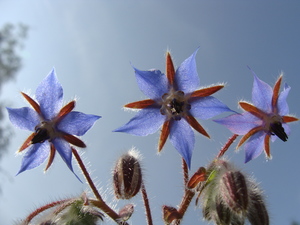
|
Borage |
6-9
Annual
Full sun, Partial sun/shade
Dry, Moist
Light (sandy), Medium, Heavy (clay)
0.6
Herbs
Flowers, Leaves
Seed - direct sow
https://en.wikipedia.org/wiki/Borage
Medium
Common borage, Cool-tankard, Tailwort, Starflower
Boraginaceae
Borretsch
60cm
5-15 days
21°c (70°f)
Oil, Colouring, Tea
https://pfaf.org/User/Plant.aspx?LatinName=Borago officinalis
Borago
5
-2
Algeria, Baleares, Corse, France, Greece, Italy, Kriti, Libya, Morocco, Portugal, Sardegna, Sicilia, Spain, Tunisia, Yugoslavia
Alaska, Alberta, Altay, Argentina Northeast, Argentina Northwest, Argentina South, Austria, Azores, Baltic States, Belgium, Bolivia, British Columbia, Buryatiya, California, Canary Is., Central European Rus, Chile Central, Colombia, Connecticut, Cuba, Cyprus, Czechoslovakia, District of Columbia, Dominican Republic, East Aegean Is., East European Russia, Ecuador, Germany, Great Britain, Guatemala, Haiti, Honduras, Hungary, Illinois, Irkutsk, Jawa, Kamchatka, Kazakhstan, Kirgizstan, Krym, Kuril Is., Lebanon-Syria, Madeira, Maine, Manitoba, Massachusetts, Mexico Central, Mexico Southwest, Michigan, Minnesota, Montana, Netherlands, New Brunswick, New Hampshire, New Jersey, New York, New Zealand North, New Zealand South, Newfoundland, North Caucasus, North Dakota, North European Russi, Northwest European R, Nova Scotia, Ohio, Ontario, Oregon, Pennsylvania, Peru, Poland, Primorye, Prince Edward I., Puerto Rico, Québec, Rhode I., Romania, Sakhalin, Saskatchewan, South European Russi, Switzerland, Tasmania, Tubuai Is., Turkey, Turkey-in-Europe, Turkmenistan, Ukraine, Uruguay, Utah, Vermont, Virginia, Washington, West Siberia, West Virginia, Wisconsin
At last frost
0.3
https://powo.science.kew.org/taxon/urn:lsid:ipni.org:names:113618-1
Dye, oil, Dynamic accumulator
true
|
Borage, also known as Borago officinalis, is a herb native to the Mediterranean region. It is a hairy, annual herb that grows to a height of about 60 cm, with blue, star-shaped flowers and large hairy leaves. The plant is easily differentiated from similar plants by its hairy stems and leaves, and its bright blue flowers. Borage prefers well-drained soil and full sun, and grows best in warm temperatures. It is a fast-growing plant, and can be easily cultivated by direct sowing or transplanting seedlings. Borage is not winter hardy, and should be grown as an annual in most climates. The leaves and flowers of borage are edible, and can be used in salads, soups, and other dishes. The leaves have a cucumber-like flavor, while the flowers are slightly sweet. The edible parts of the plant can be stored by freezing or drying. Borage has several medicinal uses, and has been used traditionally to treat a variety of ailments, including respiratory problems, skin irritation, and anxiety. It is also a good source of nutrients, including calcium, potassium, and vitamin C. In addition to its medicinal uses, borage has value as a companion plant in the garden. It attracts pollinators, such as bees and butterflies, and can be used as a natural pest deterrent. #### Propagation Direct sow early spring when temperatures reach 21°C (70°F). Best sown directly, as borage develops a delicate taproot. #### Links [Borage @ West Coast Seeds](https://www.westcoastseeds.com/products/borage) |
Show
Edit |

|
Chives |
3-12
Full sun, Partial sun/shade
Moist
Light (sandy), Medium, Heavy (clay)
6.0-7.0
0.3
0.45
Perennial
Herbs
Medium
8-12inches
Seed - direct sow, Seed - transplant, Division
4-6 weeks before last frost
14-21 days
21°c (70°f)
antifungal, Dynamic accumulator, Ground cover, Fragrance
true
Flowers, Leaves, Root
Wild chives, Flowering onion
Schnittlauch
Alliaceae
Allium
Afghanistan, Alaska, Albania, Alberta, Altay, Austria, Baltic States, Belarus, British Columbia, Bulgaria, Buryatiya, Central European Rus, Chita, Colorado, Connecticut, Corse, Czechoslovakia, Denmark, East European Russia, Finland, France, Germany, Great Britain, Greece, Idaho, Iran, Iraq, Irkutsk, Italy, Japan, Kamchatka, Kazakhstan, Khabarovsk, Korea, Krasnoyarsk, Kuril Is., Labrador, Magadan, Maine, Manitoba, Massachusetts, Michigan, Minnesota, Mongolia, Montana, Netherlands, New Brunswick, New Hampshire, New Jersey, New York, North Caucasus, North European Russi, Northwest European R, Northwest Territorie, Norway, Nova Scotia, Nunavut, Ohio, Ontario, Oregon, Pakistan, Pennsylvania, Poland, Portugal, Primorye, Prince Edward I., Québec, Rhode I., Romania, Sakhalin, Saskatchewan, South European Russi, Spain, Sweden, Switzerland, Tadzhikistan, Transcaucasus, Turkey, Tuva, Ukraine, Vermont, Washington, West Himalaya, West Siberia, Wisconsin, Wyoming, Xinjiang, Yakutskiya, Yugoslavia, Yukon
Argentina South, Azores, Belgium, Comoros, Cuba, Dominican Republic, Falkland Is., Haiti, Illinois, Ireland, Jamaica, Maryland, Newfoundland, Seychelles, Trinidad-Tobago
https://en.wikipedia.org/wiki/Chives
https://pfaf.org/User/Plant.aspx?LatinName=Allium schoenoprasum
https://powo.science.kew.org/taxon/urn:lsid:ipni.org:names:528823-1
|
Chives (Allium schoenoprasum) are a bulb-forming herbaceous perennial plants that belong to the same family as onions, garlic, and leeks. They are native to Europe, Asia, and North America, and are commonly grown in gardens for their delicate onion flavor and attractive purple flowers. Chives are easy to grow and require little maintenance. They can be grown in pots or containers, or directly in the ground. The plants have thin, hollow leaves that grow in tight clumps and reach a height of around 12-20 inches (30-50 cm). The bulbs are slender, conical, 2–3 cm (3⁄4–1 1⁄4 in) long and 1 cm (1⁄2 in) broad, and grow in dense clusters from the roots. The scapes (or stems) are hollow and tubular, up to 50 cm (20 in) long and 2–3 mm (1⁄16–1⁄8 in) across, with a soft texture, although, prior to the emergence of a flower, they may appear stiffer than usual. The grass-like leaves, which are shorter than the scapes, are also hollow and tubular, or terete, (round in cross-section) which distinguishes it at a glance from garlic chives (Allium tuberosum). The flowers are pale purple, and star-shaped with six petals, 1–2 cm (1⁄2–3⁄4 in) wide, and produced in a dense inflorescence of 10-30 together; before opening, the inflorescence is surrounded by a papery bract. The seeds are produced in a small, three-valved capsule, maturing in summer. The herb flowers from April to May in the southern parts of its habitat zones and in June in the northern parts. Chives are often used as a seasoning in a variety of dishes, including soups, omelets, and dips. They can also be added to melted butter to make a simple but flavorful sauce for steamed vegetables. Chives are low in calories and a good source of vitamin C, making them a healthy addition to any diet. |
Show
Edit |
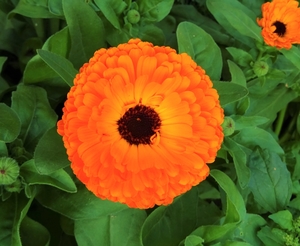
|
Pot marigold |
2-11
Full sun, Partial sun/shade
Moist
Light (sandy), Medium, Heavy (clay)
5.5-7.0
0.6
0.3
Annual
Medium
15cm
6-14 days
21°c (70°f)
60
Compost, Cosmetic, Dye, Essential Oil, Weather forecasting, Dynamic accumulator, Fragrance
Flowers, Leaves
Calendula, Common marigold, Scotch marigold, Ruddles
Ringelblume
Asteraceae or compositae
Spain
Afghanistan, Albania, Argentina Northeast, Argentina Northwest, Argentina South, Assam, Austria, Azores, Baleares, Baltic States, Belarus, Belgium, Bolivia, Borneo, British Columbia, Bulgaria, California, Canary Is., Central European Rus, Chatham Is., Chile Central, Chile North, Chile South, China North-Central, China South-Central, China Southeast, Colombia, Connecticut, Cook Is., Corse, Costa Rica, Cyprus, Czechoslovakia, East Aegean Is., East European Russia, East Himalaya, Ecuador, Ethiopia, France, Germany, Great Britain, Greece, Guatemala, Hainan, Honduras, Hungary, India, Iraq, Ireland, Italy, Jawa, Juan Fernández Is., Kazakhstan, Kriti, Krym, Lebanon-Syria, Lesser Sunda Is., Libya, Madeira, Maine, Malaya, Manchuria, Massachusetts, Mauritius, Mexico Southeast, Michigan, Morocco, Myanmar, Nepal, Netherlands, New Hampshire, New South Wales, New York, New Zealand North, New Zealand South, Newfoundland, North Caucasus, North European Russi, Northern Territory, Northwest European R, Norway, Nova Scotia, Ohio, Ontario, Pakistan, Paraguay, Pennsylvania, Peru, Philippines, Poland, Portugal, Primorye, Qinghai, Queensland, Québec, Romania, Sardegna, Sicilia, South Australia, South European Russi, Sulawesi, Sumatera, Sweden, Switzerland, Tadzhikistan, Taiwan, Tasmania, Tibet, Transcaucasus, Trinidad-Tobago, Turkey, Turkmenistan, Ukraine, Uruguay, Uzbekistan, Victoria, Vietnam, Washington, Western Australia, Wisconsin, Xinjiang, Yugoslavia
https://en.wikipedia.org/wiki/Calendula_officinalis
https://pfaf.org/User/Plant.aspx?LatinName=Calendula officinalis
https://powo.science.kew.org/taxon/urn:lsid:ipni.org:names:187894-1
4.6
Colouring, Tea
true
|
The pot marigold, also known as Calendula officinalis, is a flowering plant probably native to southwestern Asia, western Europe, and the Mediterranean region, however, its long cultivation history makes its precise origin unknown. It is a herbaceous annual plant that typically grows to be about 12-18 inches tall, with hairy stems and leaves. The leaves are lance-shaped, with a hairy surface, and the flowers can range in colour from white through yellow and orange to red and even pink. In terms of growing conditions, the pot marigold prefers well-drained soil and full sun, although it can tolerate partial shade. It is winter hardy, but may not flower as profusely in colder climates. To cultivate it successfully, a grower should plant pot marigold seeds directly in the ground after the last frost of the season. The pot marigold has a number of uses, both culinary and medicinal. The flowers are edible and can be used to add color and flavor to salads and other dishes. The petals can also be dried and used to make tea. In terms of medicinal uses, the plant has been used for centuries to treat a variety of ailments, including wounds, infections, and skin irritation. The pot marigold is also attractive to a variety of pollinators, making it a valuable plant for attracting beneficial insects to the garden. Overall, the pot marigold is a versatile and easy-to-grow plant that is well-suited to a variety of garden settings. ### Propagation - Direct sow Direct sow in spring when light frost is still possible. Can be sown until early summer for fall blooms. ### Propagation - Transplant Sow indoors in late winter, transplant outside when risk of heavy frost has passed. #### Links [Calendula @ West Coast Seeds](https://www.westcoastseeds.com/products/zeolights-organic) |
Show
Edit |
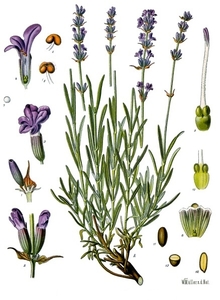
|
Lavender |
5-8
Full sun
Dry, Moist
Light (sandy), Medium, Heavy (clay)
Evergreen
1.2
0.6
Perennial
Shrubs
Slow
Companion, Essential Oil, Hedgerow, Fragrance
true
Flowers
True lavender
Lavendel
Lamiaceae or labiatae
France, Italy, Spain
Austria, Bulgaria, East Aegean Is., Germany, Krym, Marianas, New York, Tunisia, Venezuela, Vermont, West Himalaya
https://en.wikipedia.org/wiki/Lavandula_angustifolia
https://pfaf.org/User/Plant.aspx?LatinName=Lavandula angustifolia
https://powo.science.kew.org/taxon/urn:lsid:ipni.org:names:449008-1
True
No
Light
Condiment, Tea
|
Lavender, also known as Lavandula angustifolia, is a flowering plant native to the Mediterranean region. It is a small shrub with silvery-gray leaves and violet-blue flowers that bloom in the summer. The plant typically grows to a height of about 30-80 cm and has a strong, fragrant aroma. In terms of growing conditions, lavender prefers well-drained, sandy soil and full sun. It can be grown in pots or in the ground, and should be watered regularly but not overwatered. To cultivate lavender successfully, a grower should ensure that the plant receives plenty of sunlight and water, and should trim the plant regularly to promote healthy growth. Lavender has a number of uses, both culinary and medicinal. The flowers and leaves of the plant can be dried and used in a variety of dishes, such as lavender shortbread or lavender lemonade. The essential oil of lavender can also be used in aromatherapy and has a number of medicinal properties, including the ability to soothe anxiety and promote relaxation. In terms of its value for wildlife, lavender provides nectar for bees and other pollinators, and can be a valuable addition to a garden that is looking to support local wildlife. Overall, lavender is a versatile plant that is prized for its fragrant flowers and useful properties. |
Show
Edit |
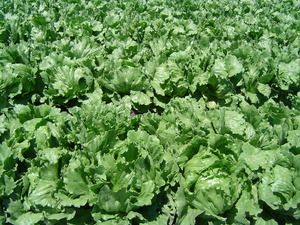
|
Lactuca sativa |
5-9
Annual, Biennial
Full sun, Partial sun/shade
Moist
Light (sandy), Medium
0.9
Herbs
true
Leaves, Seed
https://en.wikipedia.org/wiki/Lettuce
Garden lettuce
Asteraceae or compositae
Blattsalat
Oil
https://pfaf.org/User/Plant.aspx?LatinName=Lactuca sativa
Iraq
Alabama, Antipodean Is., Argentina Northeast, Assam, Austria, Baleares, Baltic States, Bangladesh, Belize, Bolivia, Bulgaria, Burkina, California, Cameroon, Canary Is., Cape Provinces, Cape Verde, Caroline Is., Central European Rus, Chad, China North-Central, Colombia, Connecticut, Corse, Costa Rica, Cuba, Cyprus, Czechoslovakia, Delaware, District of Columbia, Dominican Republic, East European Russia, East Himalaya, Ecuador, Egypt, El Salvador, Fiji, Finland, France, Free State, Germany, Great Britain, Guatemala, Haiti, Hawaii, Honduras, Hungary, Idaho, Illinois, Indiana, Inner Mongolia, Ireland, Italy, Jamaica, Jawa, Kazakhstan, Khabarovsk, Korea, Krym, Lebanon-Syria, Madeira, Maine, Marianas, Marshall Is., Massachusetts, Mauritania, Mauritius, Mexico Southeast, Michigan, Missouri, Myanmar, Nepal, Netherlands, New Guinea, New Hampshire, New Jersey, New Mexico, New York, Nicaragua, Niue, North Carolina, North Caucasus, North Dakota, North European Russi, Northwest European R, Ohio, Oklahoma, Oman, Ontario, Oregon, Pakistan, Panamá, Paraguay, Pennsylvania, Peru, Philippines, Poland, Portugal, Primorye, Puerto Rico, Rhode I., Romania, Réunion, Sardegna, Sicilia, South European Russi, Spain, Sweden, Switzerland, Taiwan, Transcaucasus, Trinidad-Tobago, Tubuai Is., Turkey, Turkey-in-Europe, Ukraine, Uzbekistan, Venezuela, Vermont, Vietnam, Wake I., Washington, West Virginia, Yugoslavia
30cm
https://powo.science.kew.org/taxon/urn:lsid:ipni.org:names:228239-1
Hair, oil, Pest control
|
Lettuce, Lactuca sativa, is a plant native to the Mediterranean region. It has green, elongated leaves that form a loose head. The stem is relatively short and the plant grows to a height of about 8-12 inches. Lettuce is a fast-growing plant, with some varieties able to be harvested in as little as 45 days. Lettuce can be differentiated from similar plants by its elongated leaves and loose head formation. It is also relatively short compared to other leafy green plants like kale and spinach. Lettuce prefers cool temperatures and grows best in full sun or partial shade. It is a hardy plant and can tolerate light frost, but will not survive extreme cold. To cultivate lettuce successfully, growers should ensure that the soil is well-drained and moist, and that the plants are spaced appropriately. Lettuce is edible and the leaves can be eaten raw in salads or cooked. The leaves can also be stored by washing and drying them, and then wrapping them in a damp paper towel before placing them in the refrigerator. Lettuce has a number of uses. It is a popular ingredient in salads and other dishes, and has been used medicinally to treat a variety of ailments, including insomnia and digestive issues. |
Show
Edit |

|
Allium cepa |
3-9
Annual
Full sun
Moist
Light (sandy), Medium
0.6
Herbs
Flowers, Leaves, Root, Seed
Seed - direct sow, Seed - transplant
https://en.wikipedia.org/wiki/Onion
Garden onion
Alliaceae
Zwiebel
https://pfaf.org/User/Plant.aspx?LatinName=Allium cepa
50°f, 10°c
Seed indoors 6 weeks before transplanting in the garden
2-6 inches
6.0-7.0
Allium
Turkmenistan
Algeria, Argentina Northeast, Arkansas, Baltic States, Bangladesh, Belarus, Bulgaria, California, Cambodia, Canary Is., Central European Rus, China North-Central, China South-Central, China Southeast, Colombia, Cuba, Czechoslovakia, Dominican Republic, East Aegean Is., East European Russia, East Himalaya, Ecuador, Egypt, Ethiopia, Fiji, France, Galápagos, Guinea-Bissau, Haiti, Illinois, India, Iraq, Italy, Jamaica, Kansas, Kentucky, Kirgizstan, Korea, Krym, Libya, Louisiana, Madeira, Manchuria, Mauritania, Mexico Central, Mexico Gulf, Mexico Northeast, Mexico Southeast, Mexico Southwest, Minnesota, Montana, Morocco, New York, Niue, North European Russi, Northwest European R, Oregon, Pakistan, Puerto Rico, Seychelles, South European Russi, Spain, Tadzhikistan, Texas, Thailand, Tibet, Tonga, Trinidad-Tobago, Ukraine, Uzbekistan, Vermont, Washington, West Himalaya, West Siberia, Wisconsin, Xinjiang, Yugoslavia
Spring or fall
0.3
https://powo.science.kew.org/taxon/urn:lsid:ipni.org:names:527795-1
Cosmetic, Dye, Hair, Polish, Rust
true
|
Onion (Allium cepa) is a plant species in the family Amaryllidaceae. It is native to central Asia and is commonly grown as a vegetable in many parts of the world. Onions are biennial plants, meaning they typically have a two-year life cycle. In the first year, the onion forms a small, rounded bulb with thin, papery skin. In the second year, the onion will produce a tall stem with hollow, elongated leaves and a small, spherical flower head. Onions are typically grown for their bulbs, which are used as a food ingredient in many dishes. The bulbs can vary in size and shape, depending on the variety, but are generally spherical or oblong in shape and range in size from about 2-4 inches in diameter. Onions are commonly differentiated by their color, which can range from white to yellow to red. Onions prefer well-drained soil that is rich in organic matter. They should be planted in a sunny location and will benefit from regular watering, especially during dry periods. Onion bulbs can be harvested when they reach the desired size, typically after about 100-150 days of growth. To store onions, they should be dried and cured in a cool, dry place for about two weeks before being placed in a mesh bag or other breathable container. Onions are edible and are commonly used as a food ingredient in many dishes. The bulbs are the most commonly used part of the plant, but the leaves and stems can also be used in cooking. Onions have a pungent, spicy flavor and are often used to add flavor to soups, stews, and other dishes. Onions can be stored for several months if properly dried and cured. In addition to their use as a food ingredient, onions have also been used for their medicinal properties. They have been used to treat a variety of ailments, including coughs, colds, and respiratory infections. Onions are also sometimes used as a natural fertilizer, due to the high levels of sulfur and other nutrients they contain. Onions are not known to provide significant value to wildlife. They are not a preferred food source for most animals and do not provide any significant habitat value. However, some insects, such as the onion maggot, can be pests of onion crops. |
Show
Edit |

|
Sage |
3-11
Annual, Perennial
Full sun
Dry, Moist
Light (sandy), Medium
Evergreen
0.6
Herbs
Flowers, Leaves
https://en.wikipedia.org/wiki/Salvia_officinalis
Medium
Kitchen sage, Small Leaf Sage, Garden Sage, Adacayi, Broadleaf sage, Ching-chieh, Common sage, Echter salbei, Mariyamiya, Sa er wei ya, Salbei, Salie, Salva, Salvia, Sauge commune, Sauge officinale, Sauge, Shalfey, True sage
Lamiaceae or Labiatae
Salbei
https://pfaf.org/User/Plant.aspx?LatinName=Salvia officinalis
Albania, France, Germany, Greece, Italy, Spain, Switzerland, Yugoslavia
Alabama, Algeria, Austria, Azores, Baleares, Bulgaria, California, Canary Is., Connecticut, Czechoslovakia, Georgia, Idaho, Kentucky, Korea, Libya, Maine, Maryland, Michigan, Morocco, New York, Ohio, Ontario, Oregon, Pennsylvania, Portugal, Québec, Rhode I., Romania, Sardegna, Sicilia, South European Russi, Tennessee, Transcaucasus, Tunisia, Turkey-in-Europe, Ukraine, Uruguay, Utah, Vermont, Virginia, Washington, West Virginia
0.75
https://powo.science.kew.org/taxon/urn:lsid:ipni.org:names:456833-1
Condiment, Tea
Compost, Essential Oil, Strewing, Teeth, Dynamic accumulator, Ground cover, Fragrance
true
|
Sage is a perennial herb native to the Mediterranean region. It has woody stems with gray-green leaves that are typically 2-4 inches long and have a soft, velvety texture. The flowers of sage are small and typically blue or purple, although they can also be white or pink. Sage grows to a height of about 2-3 feet and has a spreading habit. Sage prefers well-drained, sandy soil and full sun, and is drought-tolerant once established. It is winter hardy in most climates, but may need to be protected in very cold regions. To cultivate sage successfully, it is important to prune the plant regularly to promote new growth and prevent the plant from becoming woody. The leaves of sage are edible and have a strong, savory flavor. They can be used fresh or dried and are often used in dishes such as stuffings, sausages, and marinades. The leaves can also be stored for later use by drying them and storing them in an airtight container. Sage has a number of uses beyond its culinary value. It has traditionally been used for its medicinal properties, and is said to have antibacterial and anti-inflammatory effects. It is also often used as a fertility herb and is said to promote lactation in nursing mothers. Sage can also be used as a natural insect repellent and as a mulch to suppress weeds. Sage is valued by wildlife for its nectar, which attracts bees and other pollinators. It is also an important host plant for the larvae of several species of butterflies and moths. In addition, the leaves of sage can be used as a natural insecticide to control aphids and other garden pests. In humid zones above 9 it might be only possible to grow as an annual. |
Show
Edit |
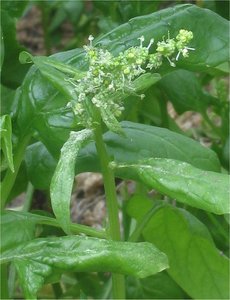
|
Spinach |
4-8
Full sun, Partial sun/shade
Moist
Light (sandy), Medium, Heavy (clay)
0.3
0.3
Annual
Herbs
Fast
Seed - direct sow, Seed - transplant
3 weeks prior to last frost date
2 weeks
Leaves, Seed
Spinat
Chenopodiaceae
Altay, Kazakhstan, Turkmenistan, Uzbekistan
Afghanistan, Algeria, Amur, Bangladesh, California, Canary Is., Cayman Is., Connecticut, Czechoslovakia, Denmark, Dominican Republic, East Aegean Is., Greece, Haiti, India, Inner Mongolia, Iran, Japan, Korea, Kriti, Laos, Lebanon-Syria, Libya, Maine, Marianas, Massachusetts, Morocco, New Hampshire, New York, North Carolina, Norway, Ohio, Oregon, Pakistan, Pennsylvania, Primorye, Rhode I., Saudi Arabia, South Carolina, Sweden, Tadzhikistan, Tunisia, Vietnam, Virginia, Washington, Yemen
https://en.wikipedia.org/wiki/Spinach
https://pfaf.org/User/Plant.aspx?LatinName=Spinacia oleracea
https://powo.science.kew.org/taxon/urn:lsid:ipni.org:names:167384-1
from March to June; Aug to Sep
start seeds indoors 8 weeks prior to last frost date
carminative, laxative, hypoglycaemic; against inflammation
Colouring
Dye
true
|
Spinach (Spinacia oleracea) is a leafy green vegetable native to central and southwestern Asia. The plant has smooth, glossy, and dark green leaves that are arranged in a rosette pattern. It has a long, thick stem that is typically green or red in color, depending on the variety. The plant grows to a height of 6-8 inches and produces small, inconspicuous flowers. Spinach grows best in cool, moist conditions and prefers full sun or partial shade. To cultivate it successfully, the soil should be well-draining and rich in organic matter. The plant can be grown from seed and is typically ready for harvest in about 50-60 days. Successional sowing once per month/every two weeks is recommended for continuous supply. Spinach is highly nutritious and is a good source of vitamins A, C, and K, as well as calcium, potassium, and iron. The edible parts of the plant include the leaves and stems, which can be eaten fresh or cooked. Spinach should be stored in the refrigerator and used within a few days of harvest to maximize its nutritional value. In addition to its culinary uses, spinach has been used medicinally to treat a variety of conditions, including anemia, high blood pressure, and inflammation. The plant can also be used as a fertilizer, as its leaves are rich in nitrogen and other nutrients. Spinach can provide valuable habitat and food for a variety of wildlife, including birds and insects. |
Show
Edit |
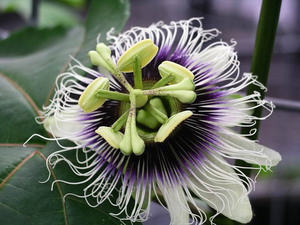
|
Passiflora edulis |
https://en.wikipedia.org/wiki/Passiflora_edulis
true
Fast
Moist
Full sun
9-12
Vines
Purple granadilla, passion fruit, granadilla, aul aanp, bai xiang guo, buah negeri, buah susu, garendal, granadiglia, granadilho, grenadille, ji dan guo, kudamonotokeiso, liliko'i, linmangkon, louki, magalendendele, maracuja-roxo, maracuya, markisa, maseche, matunda, munchi, obutunda, pasionaria, purpurgrenadille, qaranidila, sawarot, soh-brap, tikeiso, common passionfruit, fleur de la passion, flor de la pasión, granadiglia incarnata, granadilla, grenadella, kalala, maracayú, maracujá, maracujá azedo, maracujá-comum, maracujá-de-comer, maracujá-de-ponche, maracujá-do-mato, maracujá-doce, maracujá-mirim, maracujá-peroba, maracujá-preto, maracujá-redondo, maracuya, pasiflora, passiflora, passiflorae acetum folium, passiflore, passion flower, passion fruit, passion fruit|wel dodam, passionsblume, passionsfrukt, purple granadilla, purple passionflower
Light (sandy), Medium, Heavy (clay)
Passifloraceae
9.0
Oil, Drink, Sweetener
Weed potential
Fruit
Perennial
https://pfaf.org/User/Plant.aspx?LatinName=Passiflora edulis
Argentina Northeast, Brazil Northeast, Brazil South, Brazil Southeast, Brazil West-Central, Paraguay
Angola, Argentina Northwest, Assam, Azores, Bangladesh, Benin, Bolivia, Borneo, Brazil North, Burundi, Cambodia, Cameroon, Canary Is., Caroline Is., Central African Repu, China South-Central, China Southeast, Colombia, Comoros, Cook Is., Costa Rica, Cuba, Dominican Republic, East Himalaya, El Salvador, Ethiopia, Fiji, Florida, Gabon, Galápagos, Gambia, Gilbert Is., Guatemala, Gulf of Guinea Is., Hawaii, Honduras, India, Jamaica, Jawa, Kenya, KwaZulu-Natal, Laos, Leeward Is., Lesser Sunda Is., Malawi, Malaya, Marianas, Marshall Is., Mauritius, Mexico Central, Mexico Northeast, Mexico Southeast, Mexico Southwest, Morocco, Mozambique, New Caledonia, New South Wales, New Zealand North, Norfolk Is., Northern Provinces, Panamá, Peru, Puerto Rico, Queensland, Rodrigues, Réunion, Sri Lanka, Sudan, Swaziland, Taiwan, Tanzania, Thailand, Tonga, Trinidad-Tobago, Uganda, Venezuela, Victoria, Vietnam, West Himalaya, Windward Is., Zambia, Zaïre, Zimbabwe
https://powo.science.kew.org/taxon/urn:lsid:ipni.org:names:321964-2
Fencing, oil, Fragrance
|
Show
Edit |
|

|
Northern Highbush Blueberry |
3-8
Full sun, Partial sun/shade
Moist
Light (sandy), Medium, Acidic
Deciduous
2.0
1
Perennial
Shrubs
Medium
Animal feed, Attracts insects, Hedgerow, Wildlife habitat
true
Fruit, Leaves
Blue huckleberry, tall huckleberry, swamp huckleberry, high blueberry, swamp blueberry, american blueberry, blueberry, blue rose tree, bluerose
Heidelbeere
Ericaceae
Alabama, Connecticut, Delaware, Florida, Georgia, Illinois, Indiana, Kentucky, Louisiana, Maine, Maryland, Massachusetts, Michigan, Mississippi, Missouri, New Brunswick, New Hampshire, New Jersey, New York, North Carolina, Nova Scotia, Ohio, Oklahoma, Ontario, Pennsylvania, Québec, Rhode I., South Carolina, Tennessee, Texas, Vermont, Virginia, West Virginia
British Columbia, Czechoslovakia, Hungary, Poland, Washington, Wisconsin
https://en.wikipedia.org/wiki/Vaccinium_corymbosum
https://pfaf.org/User/Plant.aspx?LatinName=Vaccinium corymbosum
https://powo.science.kew.org/taxon/urn:lsid:ipni.org:names:261823-2
0.4
Tea
|
Northern Highbush Blueberry (Vaccinium corymbosum) is a type of blueberry plant native to the eastern and central United States and Canada. It is a shrub that typically grows to a height of 5-12 feet, with a spreading, upright habit. The leaves are deciduous, elliptical in shape, and about 2-3 inches long. The flowers are white, bell-shaped, and about ¼ inch long. The fruit is a small, round, blue-black berry that is edible and delicious. Northern Highbush Blueberry is typically grown in well-drained, acidic soil in full sun. It requires regular watering and pruning to maintain its shape and promote fruit production. The plant can be differentiated from similar plants by its white flowers, elliptical leaves, and blue-black berries. The edible fruit of Northern Highbush Blueberry can be stored after harvest by freezing or drying. The plant has a number of uses, including as a source of fresh fruit, in jams and jellies, and in baking. It is also prized for its antioxidant and anti-inflammatory properties, and has been used in traditional medicine to treat a variety of ailments. Northern Highbush Blueberry is an important food source for a variety of wildlife, including birds and small mammals. The plant is valued for its ability to attract pollinators, and for its contributions to soil health and ecosystem diversity. |
Show
Edit |

|
Apple |
3-8
Full sun, Partial sun/shade
Moist
Light (sandy), Medium, Heavy (clay)
Deciduous
10.0
9
Perennial
Trees
Animal feed, Attracts insects, Hedgerow
True
Fruit
Oil
Appel
Æble
Rosaceae
Malus
Afghanistan, Kazakhstan, Kirgizstan, Pakistan, Tadzhikistan, Uzbekistan, Xinjiang
Alabama, Alaska, Albania, Argentina Northeast, Argentina South, Arkansas, Azores, Baleares, Baltic States, Belarus, Belgium, British Columbia, Bulgaria, California, Central European Rus, Colorado, Connecticut, Cyprus, Czechoslovakia, Delaware, Denmark, District of Columbia, East European Russia, East Himalaya, Ecuador, Falkland Is., Finland, France, Georgia, Germany, Great Britain, Greece, Hungary, Illinois, Indiana, Iowa, Iraq, Ireland, Italy, Kansas, Kentucky, Korea, Krym, Louisiana, Madeira, Maine, Manitoba, Maryland, Massachusetts, Michigan, Minnesota, Mississippi, Missouri, Montana, Nebraska, Nepal, Netherlands, Nevada, New Brunswick, New Hampshire, New Jersey, New Mexico, New South Wales, New York, Newfoundland, North Carolina, North Caucasus, North Dakota, Norway, Nova Scotia, Ohio, Ontario, Oregon, Pennsylvania, Poland, Prince Edward I., Québec, Rhode I., Romania, South Carolina, South European Russi, Spain, Sweden, Tasmania, Tennessee, Turkmenistan, Ukraine, Utah, Vermont, Victoria, Virginia, West Virginia, Wisconsin, Wyoming, Yugoslavia
https://en.wikipedia.org/wiki/Apple
https://pfaf.org/user/plant.aspx?LatinName=Malus+domestica
https://powo.science.kew.org/taxon/urn:lsid:ipni.org:names:726282-1
Apfel
|
An apple is an edible fruit produced by an apple tree (Malus domestica). Apple trees are cultivated worldwide and are the most widely grown species in the genus Malus. The tree originated in Central Asia, where its wild ancestor, Malus sieversii, is still found today. Apples have been grown for thousands of years in Asia and Europe and were brought to North America by European colonists. Apples have religious and mythological significance in many cultures, including Norse, Greek, and European Christian tradition. Apples grown from seed tend to be very different from those of their parents, and the resultant fruit frequently lacks desired characteristics. Generally, apple cultivars are propagated by clonal grafting onto rootstocks. Apple trees grown without rootstocks tend to be larger and much slower to fruit after planting. Rootstocks are used to control the speed of growth and the size of the resulting tree, allowing for easier harvesting. There are more than 7,500 known cultivars of apples. Different cultivars are bred for various tastes and uses, including cooking, eating raw, and cider production. Trees and fruit are prone to a number of fungal, bacterial, and pest problems, which can be controlled by a number of organic and non-organic means. In 2010, the fruit's genome was sequenced as part of research on disease control and selective breeding in apple production. Worldwide production of apples in 2018 was 86 million tonnes, with China accounting for nearly half of the total. From [Wikipedia](https://en.wikipedia.org/wiki/Apple) |
Show
Edit |
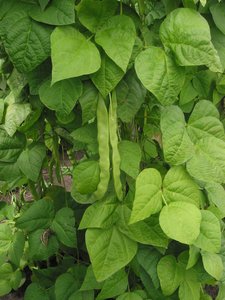
|
Common bean |
2-11
Annual
Full sun
Moist
Light (sandy), Medium, Heavy (clay)
2.0
Vines
Biomass, Dye, antifungal, Nitrogen fixer
true
Leaves, Seed, Seedpod
Seed - transplant, Seed - direct sow
https://en.wikipedia.org/wiki/Phaseolus_vulgaris
Pole bean, Climbing bean, French bean, Bush bean, Dwarf bean, Kidney bean, Green bean
Fabaceae, Leguminosae
Stangenbohne
https://pfaf.org/User/Plant.aspx?LatinName=Phaseolus vulgaris
16-18°c (70-80°f)
6.0-6.8
2.5 cm
16cm
4-10 days
45-85
Fast
Sperzieboon
Costa Rica, Guatemala, Honduras, Mexico Central, Mexico Gulf, Mexico Northeast, Mexico Northwest, Mexico Southeast, Mexico Southwest, Nicaragua, Panamá
Altay, Amur, Andaman Is., Angola, Argentina Northeast, Argentina Northwest, Assam, Baltic States, Bangladesh, Belarus, Bolivia, Bulgaria, Buryatiya, Cameroon, Cayman Is., Central European Rus, Chad, Chita, Colombia, Comoros, Cuba, Czechoslovakia, Dominican Republic, East European Russia, East Himalaya, Ecuador, Ethiopia, Guinea, Gulf of Guinea Is., Haiti, Illinois, India, Iraq, Irkutsk, Jamaica, Jawa, Kazakhstan, Kenya, Khabarovsk, Kirgizstan, Korea, Krasnoyarsk, Kuril Is., Leeward Is., Malaya, Marianas, Maryland, Mongolia, Myanmar, Nepal, New Guinea, New York, Nicobar Is., Nigeria, North Caucasus, North European Russi, Northwest European R, Pakistan, Peru, Philippines, Primorye, Puerto Rico, Queensland, Rwanda, Sakhalin, Senegal, South European Russi, Sri Lanka, Tadzhikistan, Tanzania, Thailand, Togo, Transcaucasus, Trinidad-Tobago, Turkmenistan, Tuva, Uganda, Ukraine, Uzbekistan, Venezuela, Vietnam, Wake I., West Himalaya, West Siberia, Yakutskiya, Zambia, Zaïre
2-4 weeks before last frost
1 week after last frost, 12-14 weeks before first frost
3-5 years
0.4
https://powo.science.kew.org/taxon/urn:lsid:ipni.org:names:514191-1
Coffee, Condiment
|
This entry describes all varieties of the common bean. This includes vining and bush/darf variaties and can have different names depending on their style of growths (see alternate names). These include the kidney bean, the navy bean, the pinto bean, the French bean and the wax bean The common bean, scientific name Phaseolus vulgaris, is a herbaceous annual plant native to the Americas, specifically the regions extending from the southwestern United States to South America. It is a member of the Fabaceae (legume) family. The common bean has a range of different appearances, depending on the variety. Most varieties have a simple, erect stem that grows to a height of 20-60 cm. The leaves are typically green and consist of 3-5 oblong leaflets. The flowers are small and white, pink, or purple in color. The fruit is a legume, which contains the seeds. The common bean is typically a small plant, but some varieties can grow to be quite large, reaching heights of up to 2 meters. The plant grows relatively quickly, with the growing season typically lasting between 60-100 days. The common bean prefers well-drained soil and full sun, but can also grow in partial shade. It is sensitive to frost and should be planted after the last frost date in the spring. To cultivate the common bean successfully, a grower may need to ensure that the soil is adequately fertilized and provide support for the plant to climb, if necessary. The common bean is edible, with the seeds and the young pods being the most commonly consumed parts. The seeds can be cooked and eaten as a protein-rich vegetable, and the young pods can be eaten as a green vegetable. The edible parts can be stored after harvest by drying the seeds or by preserving the young pods in vinegar or oil. The common bean has many uses beyond being a food source. The plant can fix nitrogen in the soil, improving its fertility and making it a useful companion plant for other crops. The dried leaves and stems of the common bean can be used as mulch or as a source of organic matter. In some cultures, the fibers from the stems are used to make ropes or other weaving materials. Additionally, the plant has been used medicinally to treat a variety of ailments. The common bean is also valuable for wildlife. The flowers attract bees and other pollinators, and the plant provides food for a variety of insects, birds, and small mammals. ### Links [Beans Seed Starting Tips @ Harvest to Table](https://harvesttotable.com/beans-seed-starting-tips/) ### Propagation - direct sow Direct-sow beans in spring after all danger of frost has passed and soil is at least 16°C (60°F). In warm-winter regions, sow beans in late summer for harvest in winter. Time sowing so that beans come to harvest before the first frost. |
Show
Edit |

|
Brussel Sprouts |
Full sun, Partial sun/shade
Moist
Light (sandy), Medium, Heavy (clay)
1.2
0.2
Biennial
3 to 7 years
true
Leaves
Rosenkohl
Brassicaceae or cruciferae
https://pfaf.org/User/Plant.aspx?LatinName=Brassica oleracea gemmifera
|
A leaf vegetable in the cabbage family. |
Show
Edit |
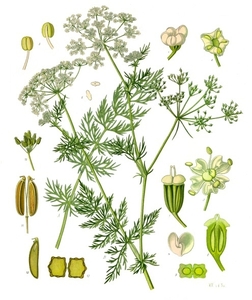
|
Carum carvi |
https://en.wikipedia.org/wiki/Caraway
true
Moist
Full sun, Partial sun/shade
3-9
Also known as persian cumin other names: alcaravia, carvi, comino, gunyun, jangli jira, jeera, jenuju, jintan, jira, kaluduru, karawya, karuwai, karwij, kim, kmin, koomen, koomlid, kummel, shia-jira, shimai-shembu, shimpaisapu, sushavi, tmin, wilayati-zirah, yuan-sui, zira, zirah-siah
Light (sandy), Medium, Heavy (clay)
Apiaceae or umbelliferae
0.6
Echter kümmel
Herbs
Leaves, Root, Seed
Weed potential
Biennial
https://pfaf.org/User/Plant.aspx?LatinName=Carum carvi
Afghanistan, Albania, Altay, Amur, Austria, Baltic States, Bangladesh, Belarus, Belgium, Bulgaria, Buryatiya, Central European Rus, China North-Central, China South-Central, Chita, Czechoslovakia, Denmark, East European Russia, East Himalaya, Finland, France, Germany, Hungary, India, Inner Mongolia, Iran, Iraq, Irkutsk, Italy, Kamchatka, Kazakhstan, Khabarovsk, Kirgizstan, Krasnoyarsk, Krym, Kuril Is., Manchuria, Mongolia, Nepal, Netherlands, North Caucasus, North European Russi, Northwest European R, Norway, Pakistan, Poland, Primorye, Qinghai, Romania, Sakhalin, South European Russi, Spain, Sweden, Switzerland, Tadzhikistan, Tibet, Transcaucasus, Turkey, Turkmenistan, Tuva, Ukraine, Uzbekistan, West Himalaya, West Siberia, Xinjiang, Yakutskiya, Yugoslavia
Alberta, Algeria, British Columbia, Colorado, Connecticut, Cyprus, District of Columbia, Føroyar, Great Britain, Greenland, Iceland, Idaho, Illinois, Indiana, Iowa, Ireland, Kentucky, Labrador, Libya, Louisiana, Maine, Manitoba, Maryland, Massachusetts, Michigan, Minnesota, Missouri, Montana, Morocco, New Brunswick, New Hampshire, New Jersey, New Mexico, New York, Newfoundland, North Carolina, North Dakota, Nova Scotia, Nunavut, Ohio, Ontario, Oregon, Pennsylvania, Prince Edward I., Québec, Rhode I., Saskatchewan, South Dakota, South Georgia, Tunisia, Utah, Vermont, Virginia, Washington, West Virginia, Wisconsin, Wyoming
https://powo.science.kew.org/taxon/urn:lsid:ipni.org:names:839677-1
Condiment, Tea
Essential Oil, Pest control, Dynamic accumulator, Fragrance
|
Show
Edit |
|
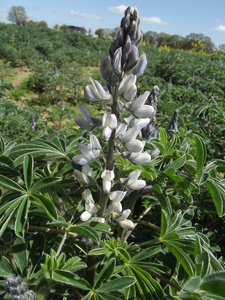
|
Lupinus albus |
https://en.wikipedia.org/wiki/Lupinus_albus
true
Moist
Full sun
Light (sandy), Medium
Fabaceae or leguminosae
1.2
Lupine
Herbs
Seed
Oil, Coffee
Annual, Perennial
https://pfaf.org/User/Plant.aspx?LatinName=Lupinus albus
Albania, Bulgaria, East Aegean Is., Greece, Kriti, Sicilia, Turkey, Turkey-in-Europe, Yugoslavia
Algeria, Azores, Baltic States, Bangladesh, Belarus, Canary Is., Central European Rus, Chile Central, Corse, Czechoslovakia, East European Russia, Egypt, France, India, Italy, Kirgizstan, Lebanon-Syria, Libya, Madeira, Morocco, Pakistan, Palestine, Portugal, Queensland, Romania, Sardegna, Spain, Transcaucasus, Tunisia, Ukraine, Western Australia
https://powo.science.kew.org/taxon/urn:lsid:ipni.org:names:504069-1
Cosmetic, Fiber, Cover crop, oil, Dynamic accumulator, Nitrogen fixer
|
Show
Edit |
|
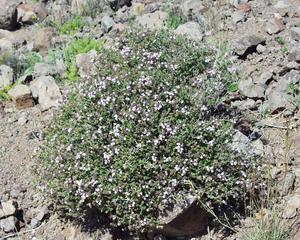
|
Thyme |
5-11
Perennial
Full sun
Dry, Moist
Light (sandy), Medium
Evergreen
0.1-0.3m
Herbs
true
Flowers, Leaves, Shoots
https://en.wikipedia.org/wiki/Thymus_vulgaris
Medium
Garden thyme, Wild Thyme, Samon-phyu, Timo, Tomillo, Thym, Common thyme, German thyme, Thyme
Lamiaceae or Labiatae
Thymian
https://pfaf.org/User/Plant.aspx?LatinName=Thymus vulgaris
Baleares, France, Italy, Spain
Algeria, Belgium, Cuba, Czechoslovakia, Dominican Republic, Haiti, Leeward Is., New Zealand South, Puerto Rico, Switzerland
0.3
https://powo.science.kew.org/taxon/urn:lsid:ipni.org:names:461765-1
Condiment, Tea
Deodorant, Disinfectant, Essential Oil, antifungal, Fragrance, Dynamic accumulator, Ground cover
|
Thyme (Thymus vulgaris) is a perennial herb that is native to the Mediterranean region. It has small, grey-green leaves and tiny, pink or purple flowers. The stems are woody and the plant grows to be about 30 cm tall. Thyme prefers well-drained, sandy soil and full sun. It is a low-maintenance plant and can be grown easily in a garden or in containers. To cultivate it successfully, it is important to water it regularly, especially during dry periods, and to trim the plant regularly to promote new growth. Thyme is edible and both the leaves and flowers can be used in cooking. They can be dried or frozen for long-term storage. The leaves have a strong, pungent flavor and are often used in meat and vegetable dishes, as well as in teas and other beverages. In addition to its culinary uses, thyme also has several medicinal properties. It has been used to treat respiratory conditions, such as bronchitis and asthma, and is also believed to have antibacterial and antifungal properties. It can also be used as a natural insect repellent. Thyme is an attractive plant that is valuable for wildlife. It is a good source of nectar for bees and other pollinators. It is also an important food plant for the caterpillars of some butterfly species. Overall, thyme is a versatile and useful herb that can be grown easily in a variety of conditions. Its flavorful leaves and attractive flowers make it a valuable addition to any garden or farm. |
Show
Edit |
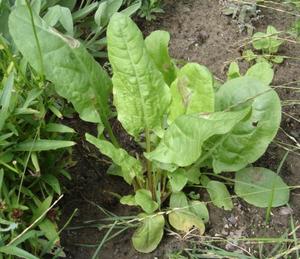
|
Sorrel |
3-7
Perennial
Full sun, Partial sun/shade
Moist
Light (sandy), Medium, Heavy (clay)
Evergreen
0.3-1.0m
Herbs
true
Flowers, Leaves, Root, Seed
Seed - direct sow, Division
1 week after last frost
https://en.wikipedia.org/wiki/Sorrel
Common sorrel, Garden sorrel, Spinach dock, Narrow-leaved dock
Polygonaceae
https://pfaf.org/User/Plant.aspx?LatinName=Rumex acetosa
6.0-7.0
Wiesen-sauerampfer, Sauerampfer, Sauerlump
1.5m
Tap
Toxic, Weed potential
Europe, Asia, North africa, Afghanistan, Albania, Altay, Amur, Austria, Baleares, Baltic States, Belarus, Belgium, Bulgaria, Buryatiya, Central European Rus, China North-Central, China South-Central, China Southeast, Chita, Corse, Czechoslovakia, Denmark, East European Russia, Finland, France, Føroyar, Germany, Great Britain, Hungary, Iceland, Inner Mongolia, Iran, Ireland, Irkutsk, Italy, Japan, Kazakhstan, Khabarovsk, Kirgizstan, Korea, Krasnoyarsk, Krym, Manchuria, Mongolia, Morocco, Nansei-shoto, Nepal, Netherlands, North Caucasus, North European Russi, Northwest European R, Norway, Pakistan, Poland, Portugal, Primorye, Qinghai, Romania, Sardegna, Sicilia, South European Russi, Spain, Sweden, Switzerland, Tadzhikistan, Taiwan, Tibet, Transcaucasus, Turkey-in-Europe, Tuva, Ukraine, Uzbekistan, West Himalaya, West Siberia, Xinjiang, Yugoslavia
Grassland
60
15-21°C (60-70°F)
10-20 days
Early spring or autumn
True
0.8
Alaska, Alberta, Aleutian Is., Argentina Northeast, Argentina South, British Columbia, Chad, Chile South, Connecticut, Haiti, Labrador, Maine, Manitoba, Massachusetts, Michigan, Minnesota, New Brunswick, New Hampshire, New York, Newfoundland, Nova Scotia, Ontario, Oregon, Pennsylvania, Québec, Saskatchewan, Svalbard, Vermont, Wisconsin
6-8 weeks before last frost
At last frost
https://powo.science.kew.org/taxon/urn:lsid:ipni.org:names:332105-2
0.4
Curdling agent
Cleanser, Dye, Polish, Dynamic accumulator
|
Sorrel, or Rumex acetosa, is a perennial herb that is native to Europe and Asia. It is a member of the Polygonaceae family, which includes other plants such as rhubarb and dock. Sorrel is known for its sharp, acidic flavor, which is often compared to that of lemon. In terms of appearance, sorrel has long, arrow-shaped leaves that grow in a rosette pattern at the base of the plant. The leaves are green in color, with a reddish-brown midrib running down the center. Sorrel also produces small, reddish-green flowers on tall, slender stalks. Sorrel typically grows to be about 1-2 feet tall, and it can spread to form a dense mat of foliage. It is a fast-growing plant, and it can be propagated easily through division of the root system. Sorrel is often distinguished from other plants by its unique flavor, as well as its arrow-shaped leaves and reddish flowers. Sorrel prefers to grow in well-drained, moist soils in full sun to partial shade. It can tolerate a wide range of soil types, but it prefers soil that is slightly acidic. Sorrel is winter hardy, and it can be grown in USDA hardiness zones 3-10. In terms of edibility, sorrel can be eaten raw or cooked. The leaves and young stems are the most commonly used parts of the plant, and they can be added to salads, soups, and stews. The flavor of sorrel is most pronounced when the leaves are young, so it is best to harvest the leaves early in the season. Sorrel can be stored in the refrigerator for a few days, or it can be frozen or dried for longer storage. Sorrel has a number of uses in the garden and on the farm. It can be used as a ground cover to suppress weeds, and its sharp flavor makes it a natural insect repellent. Sorrel can also be used as a fertilizer, as it contains high levels of nitrogen and other nutrients. Additionally, the leaves can be used as a mulch to help retain moisture in the soil. Sorrel is also valued for its medicinal properties. It has been used as a natural remedy for a wide range of ailments, including stomach aches, indigestion, and constipation. Sorrel can also be used as a natural diuretic, and it has been used to treat conditions such as gout and rheumatism. In terms of wildlife value, sorrel is a favorite food of rabbits and other herbivores. The flowers of the plant also attract a variety of insects, including bees, butterflies, and hoverflies. This makes sorrel a valuable addition to any garden or farm that is looking to support a healthy ecosystem. # Propagation The seeds need light to germinate. More easy to propagate by division in spring or autumn. Grows well in containers. # Foraging Make sure not to confuse with the toxic https://permapeople.org/plants/arum-maculatum-cuckoo-pint |
Show
Edit |